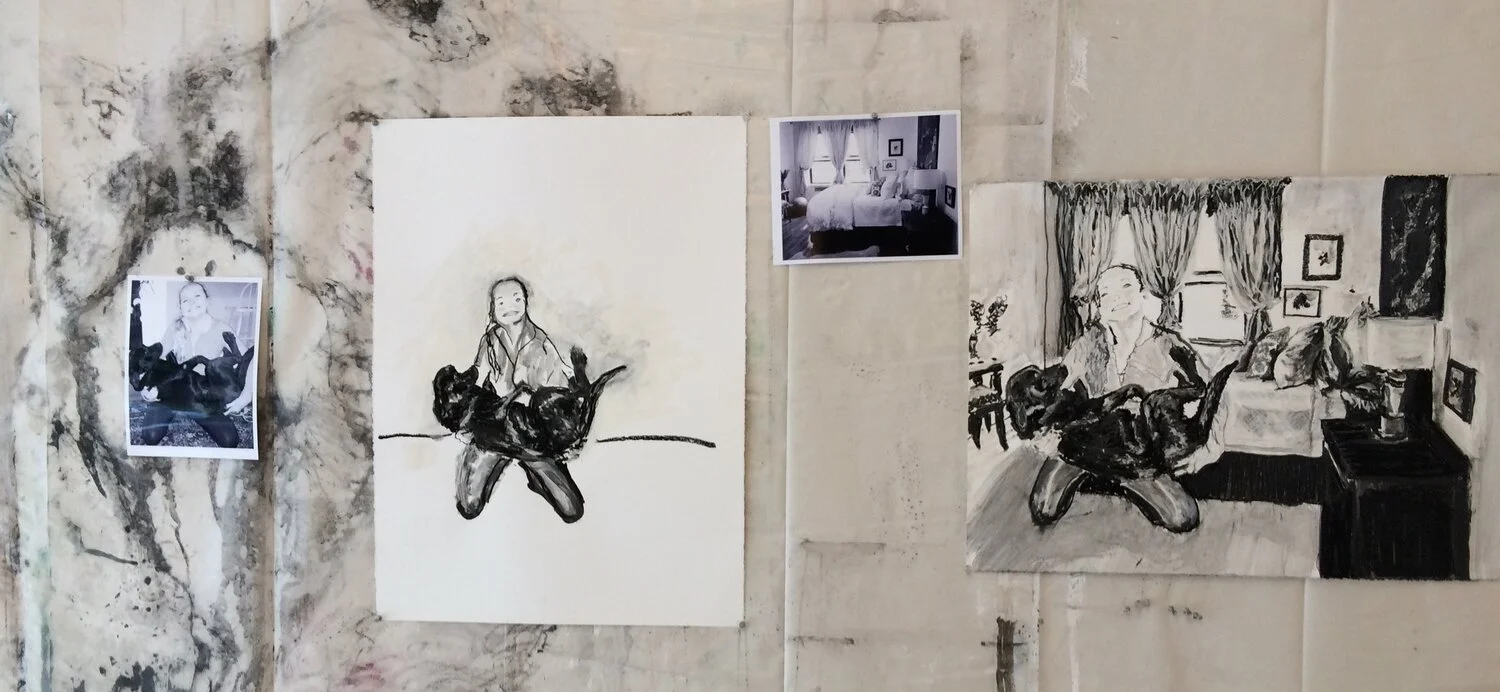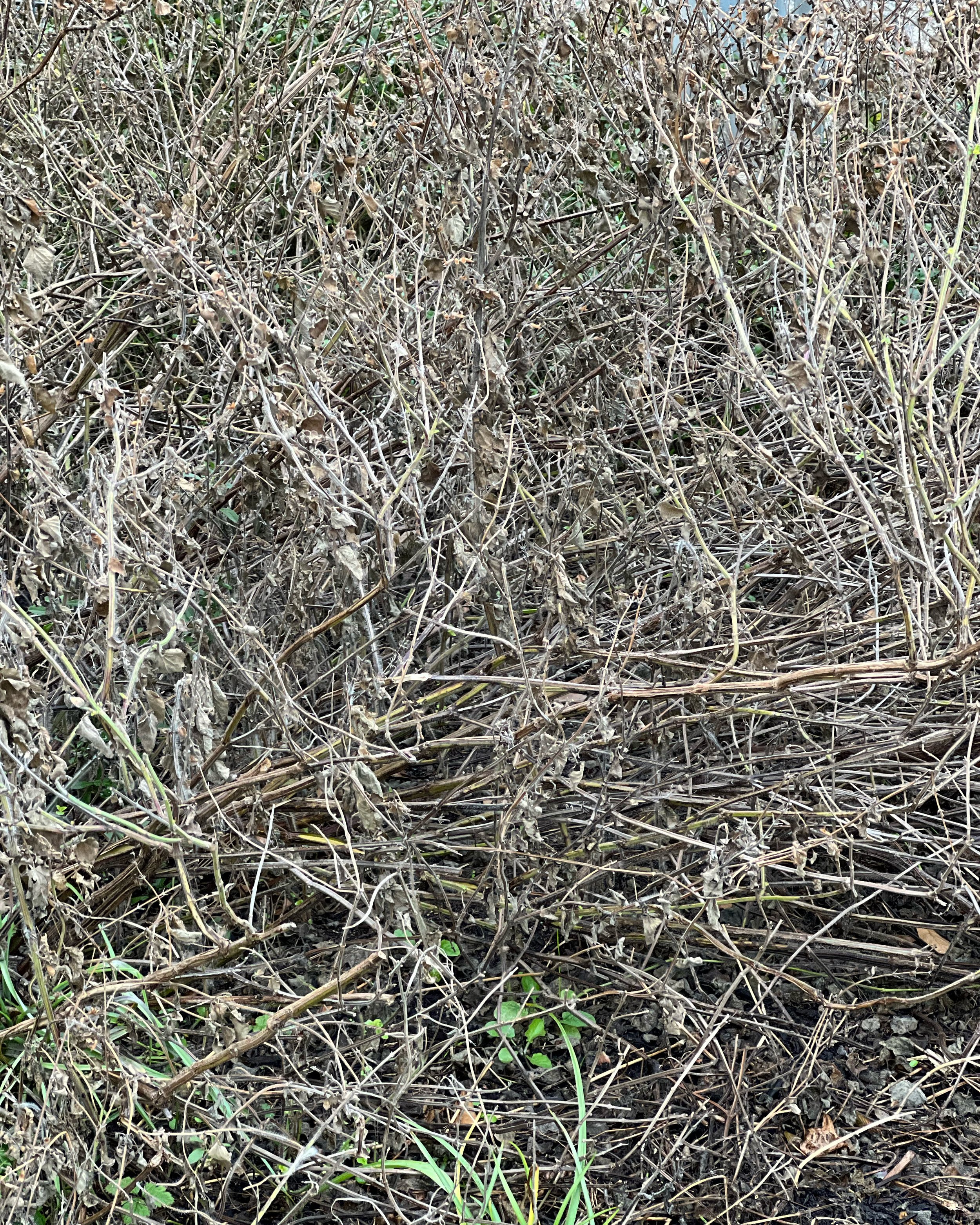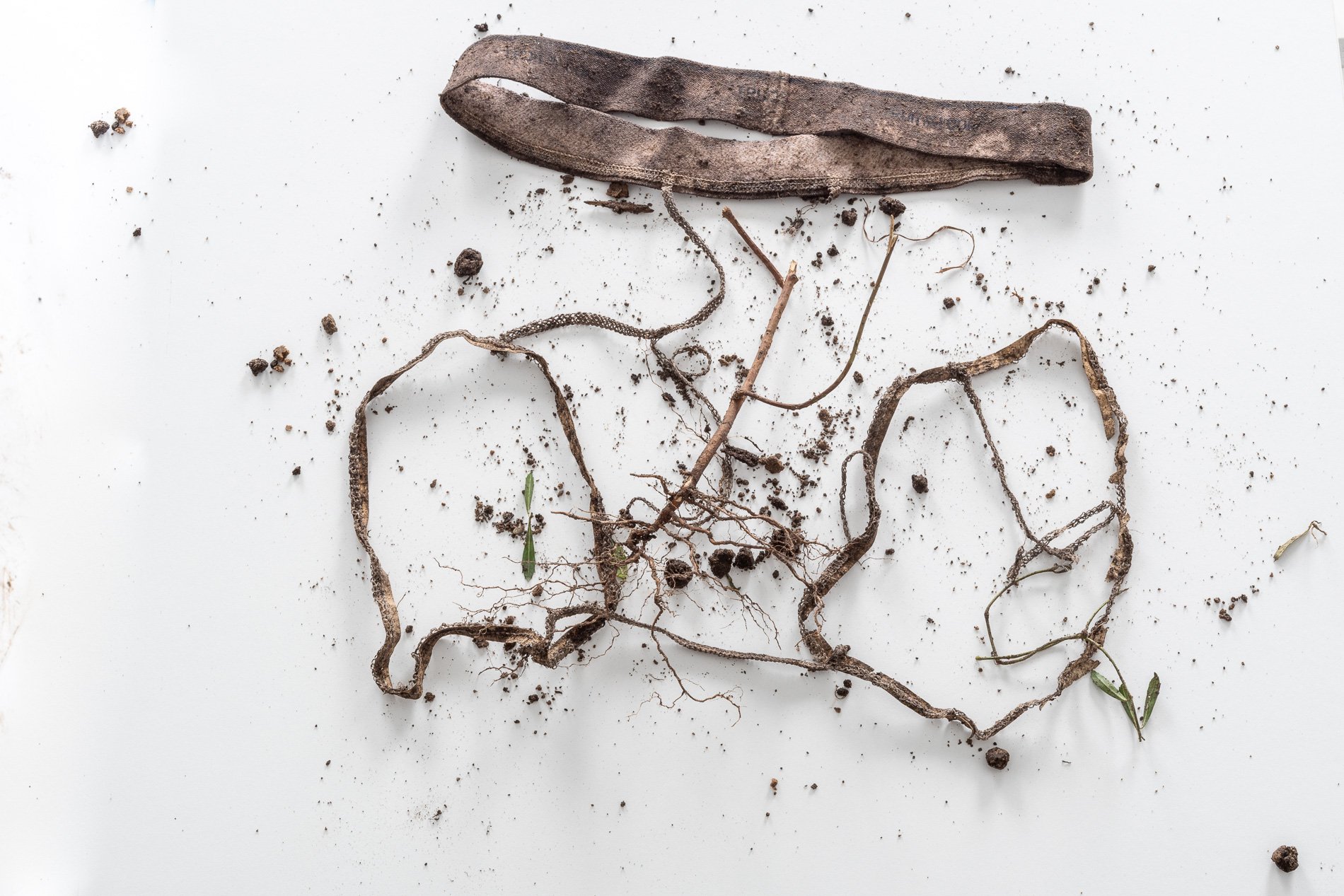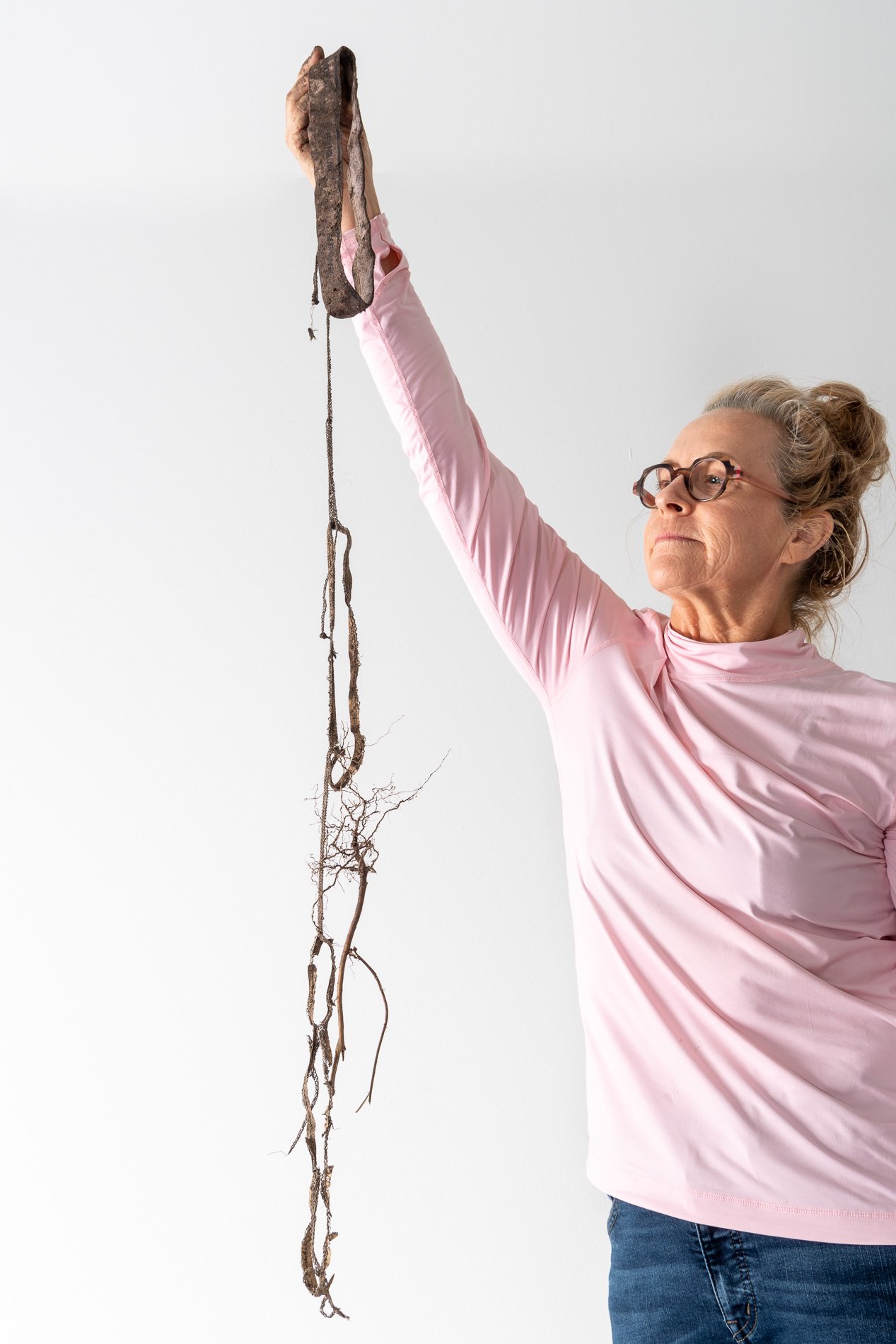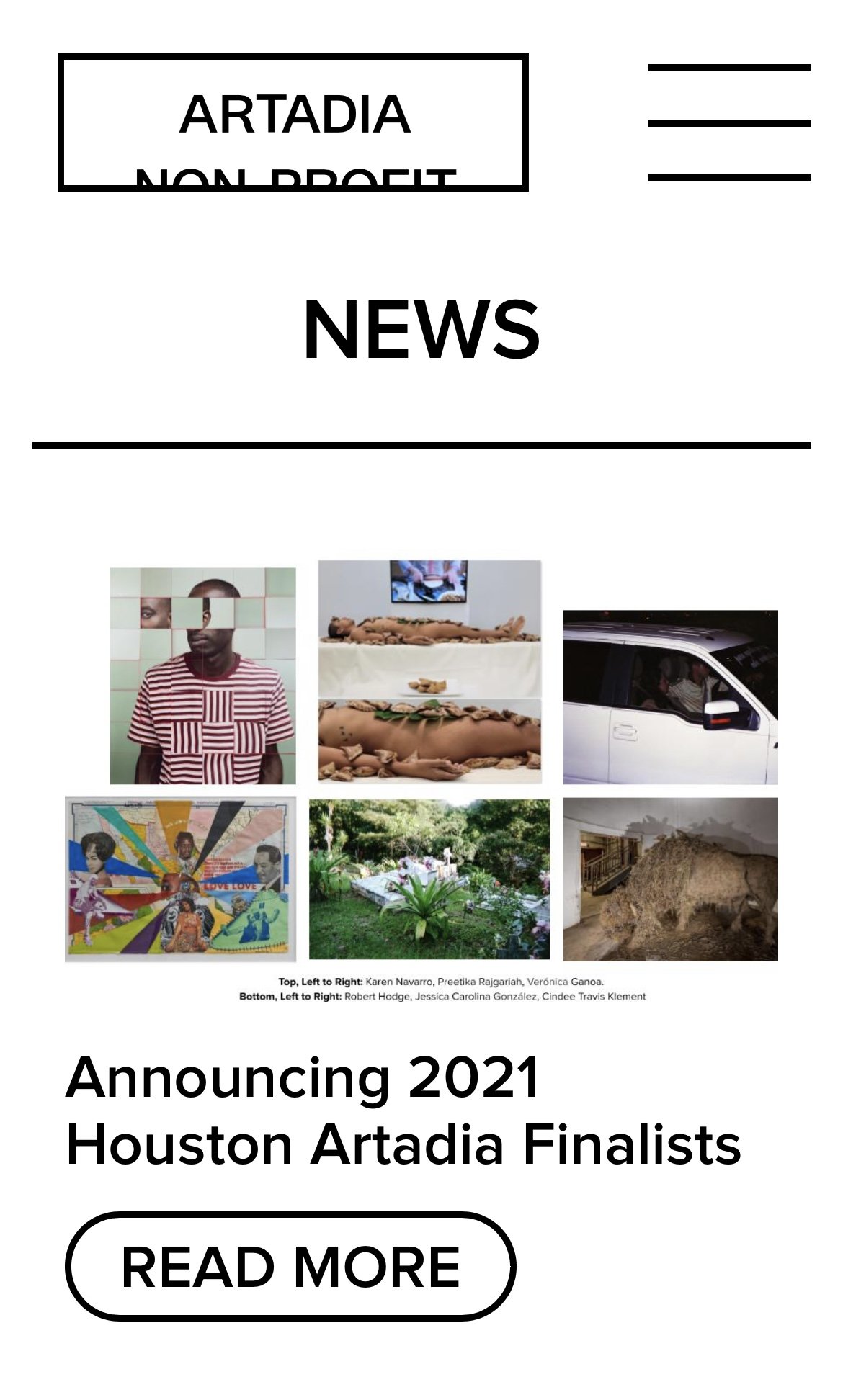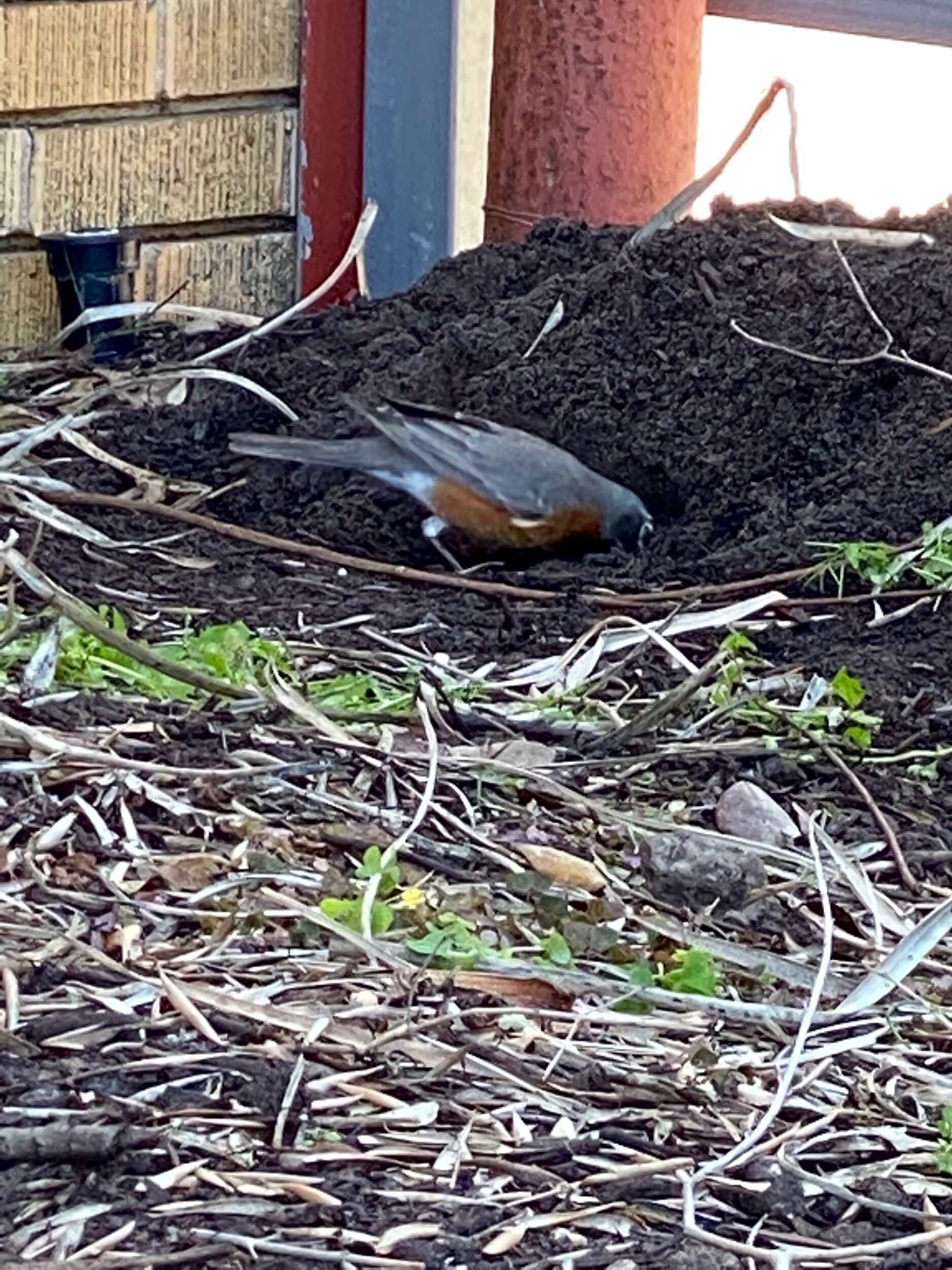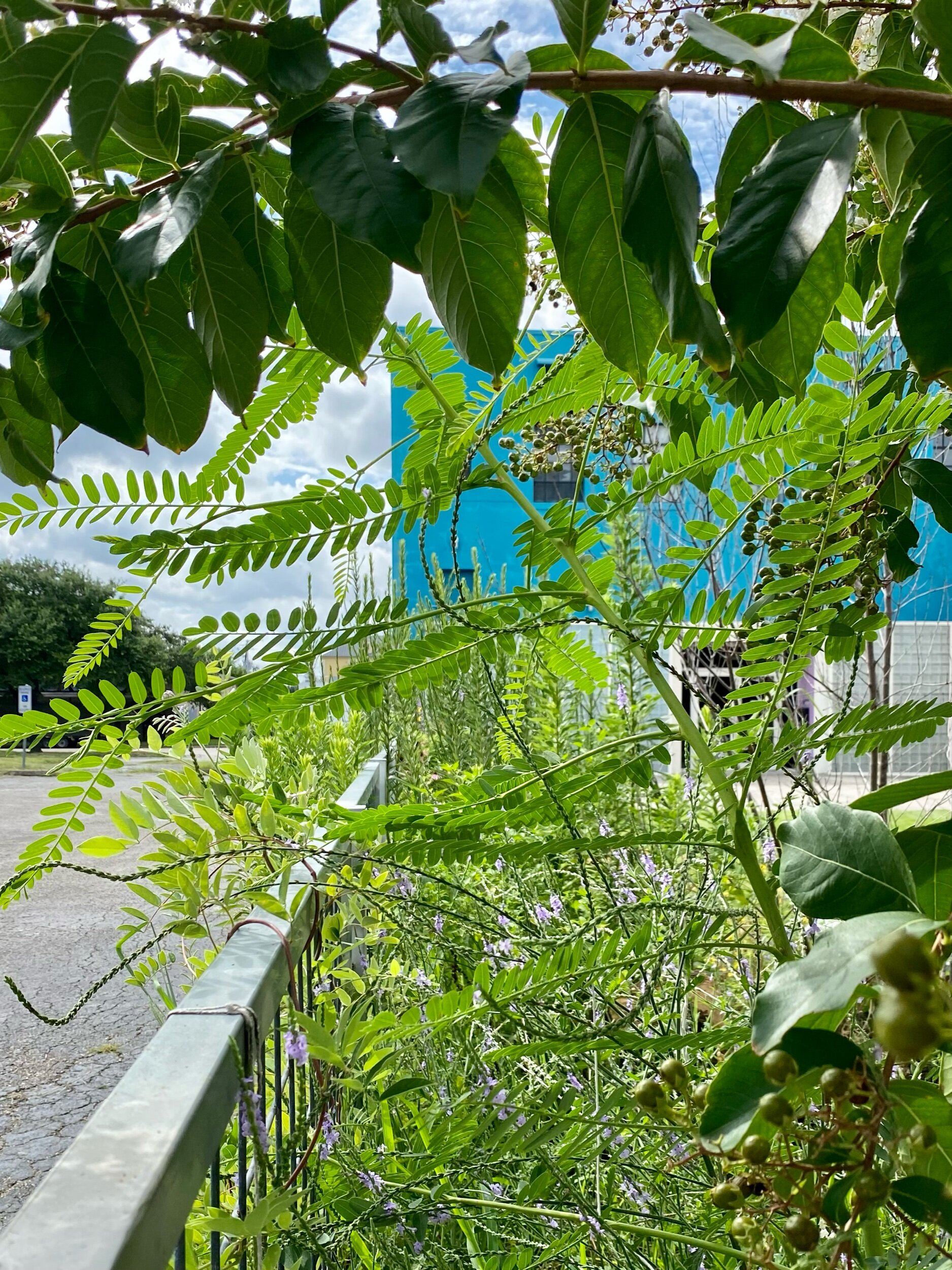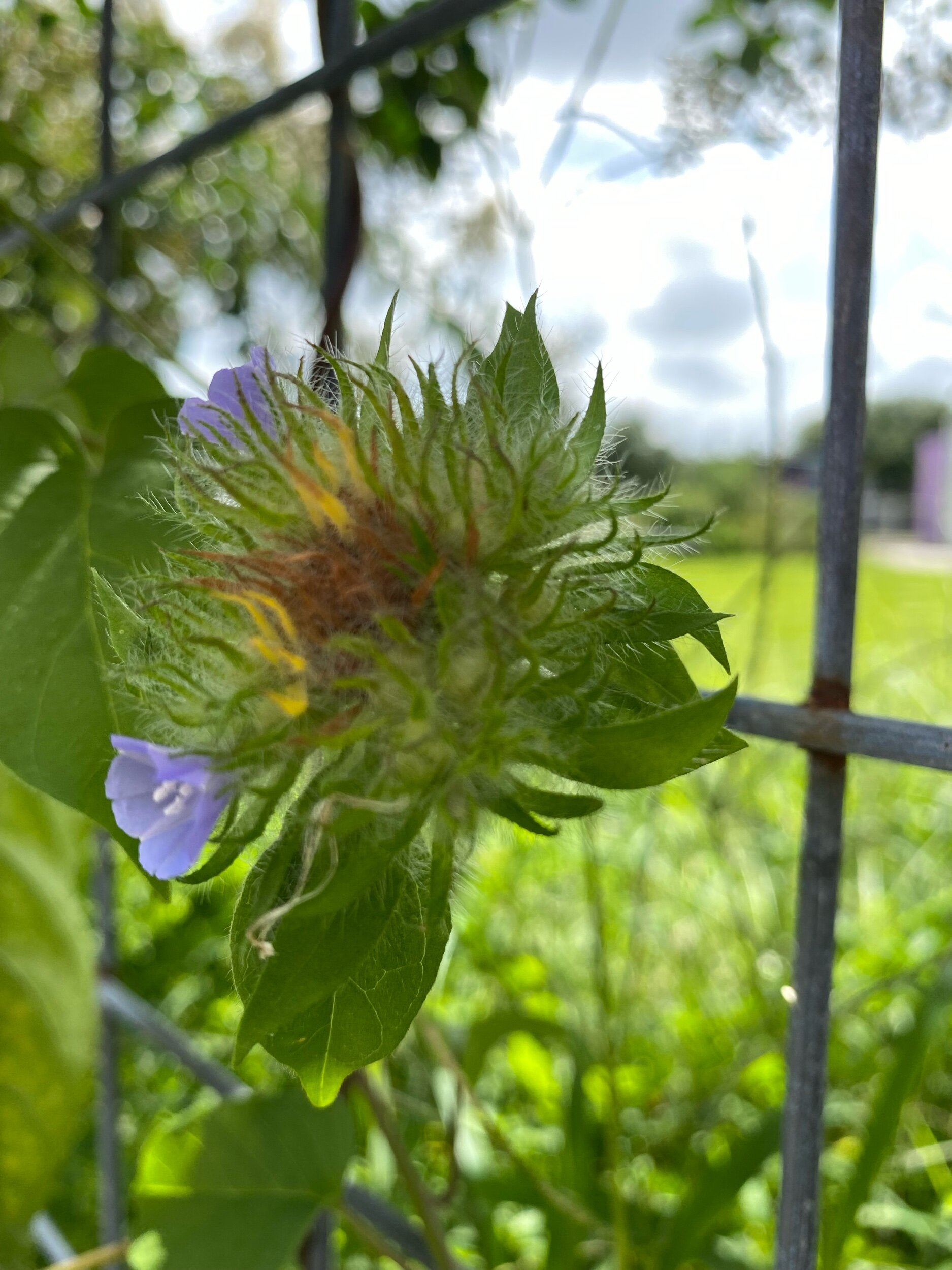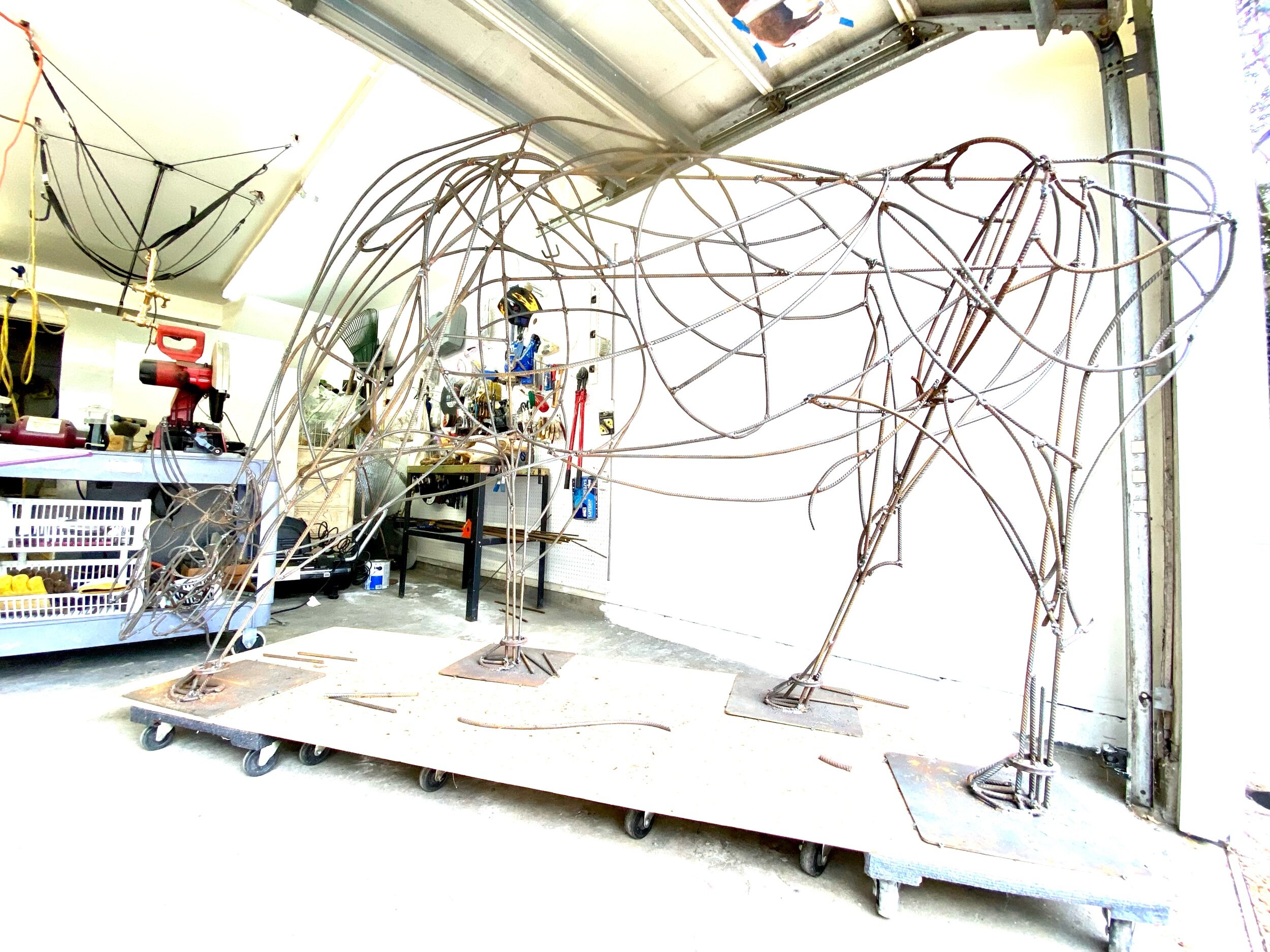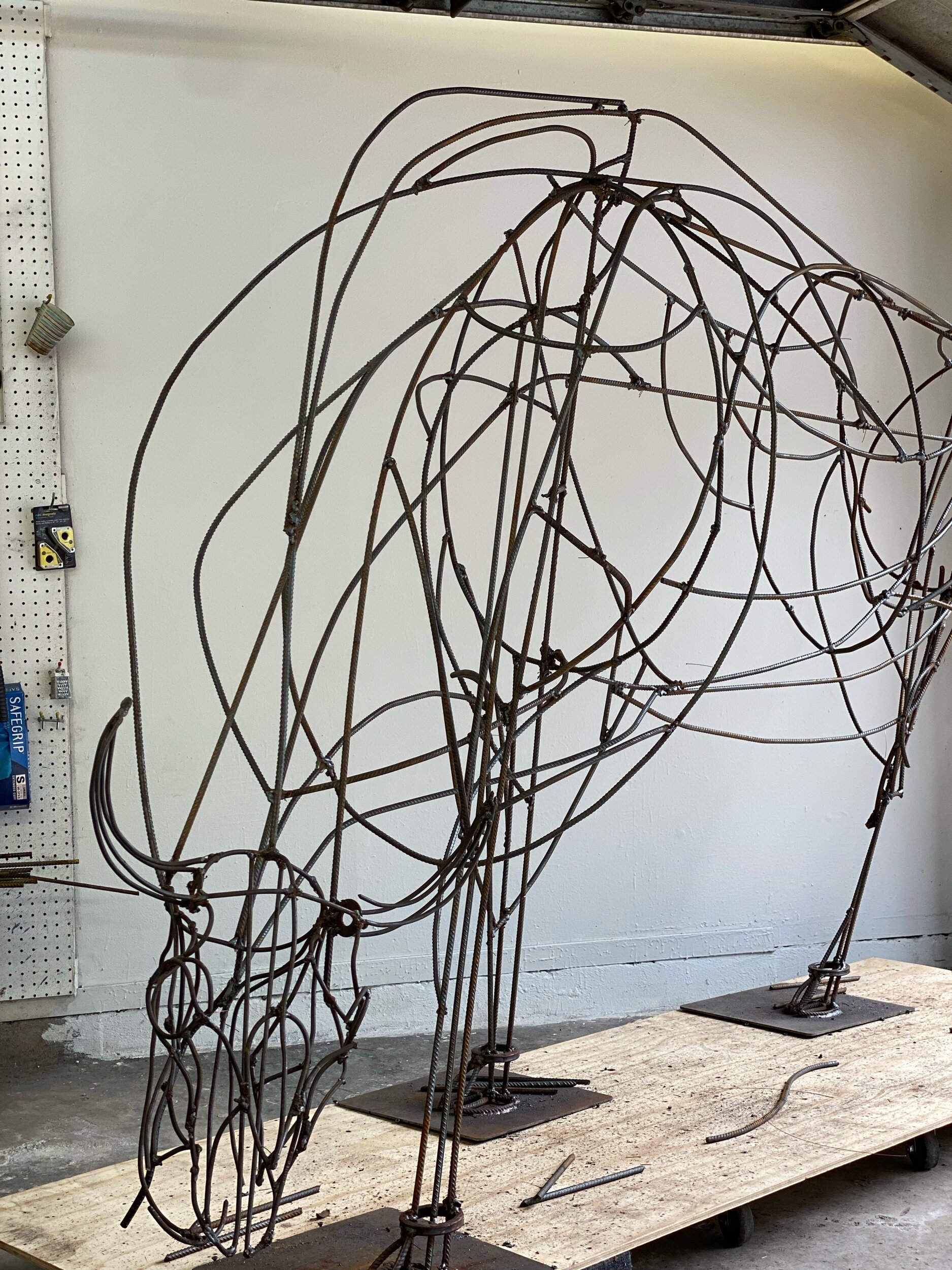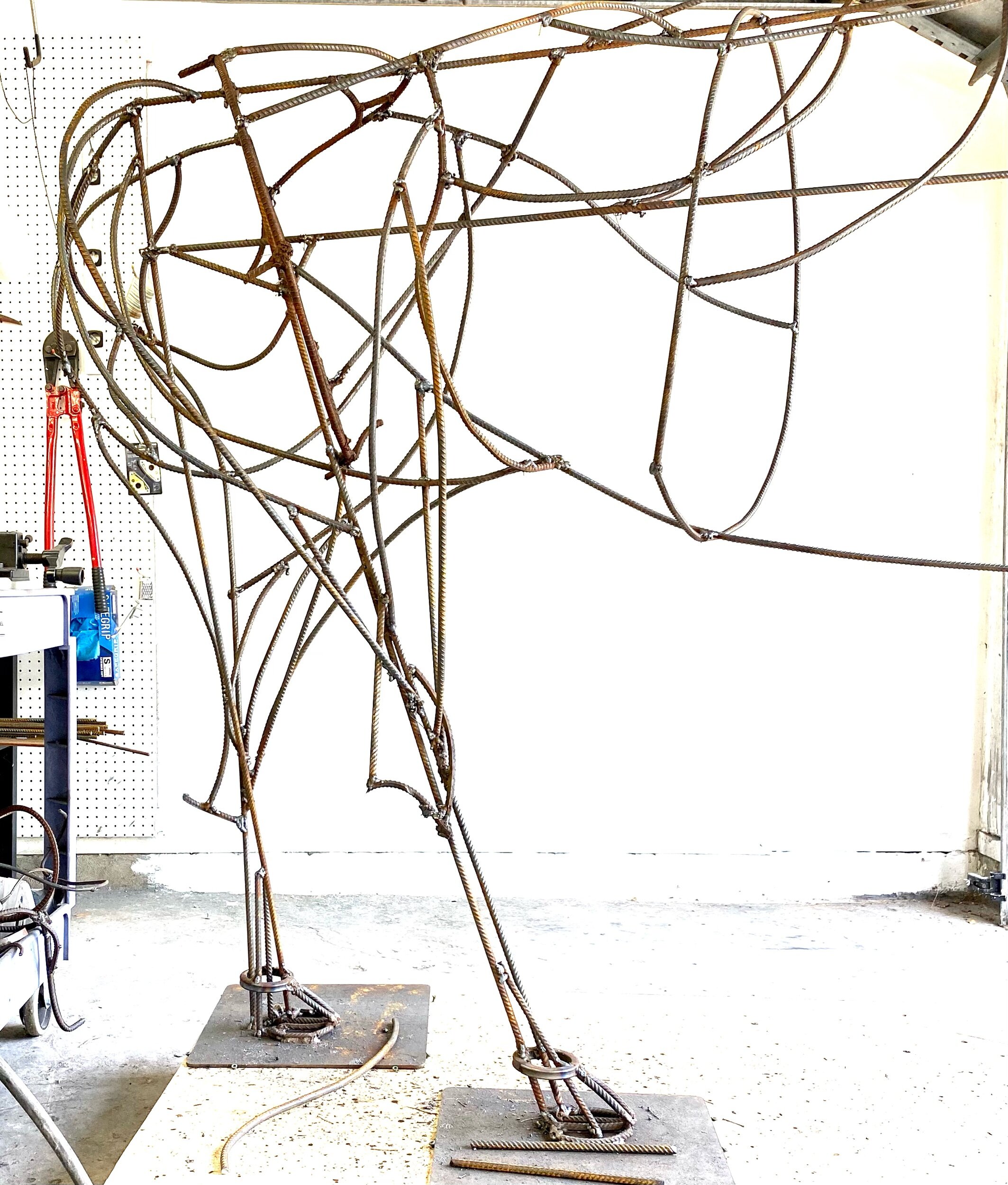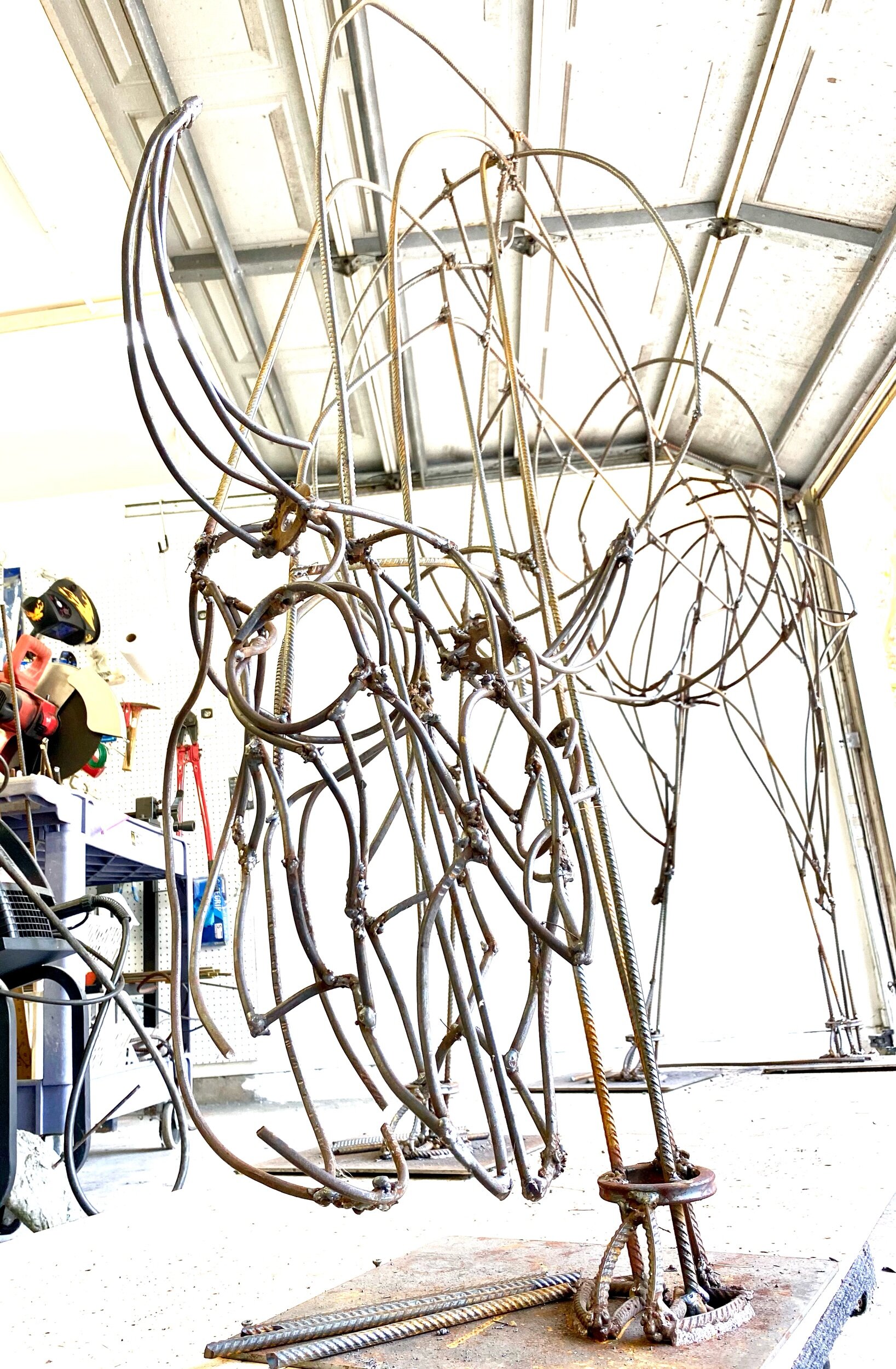When I study the areas of the work that visibly support the most wildlife in Symbiosis I often think of the the most notable works of Pollock. I am presently reading The Extended Mind by A.M. Paul. In the chapter on thinking in natural spaces she wrote. - “Nature changed Pollocks thinking - gently tempering his raging in-tensity- and it also changed his art. In New York, Pollock worked at an easel, painting intricate, involved designs. In Springs, where he worked in a converted barn full of light and views of nature, he began spreading his canvases on the floor and pouring or flinging paint from above. Art critics view this period of Pollocks life as the high point of his career, the years when he produced "drip painting" masterpieces like Shimmering Substance (1946) and Autumn Rhythm” the extended Mind by A.M. Paul. I often see Pollockness in “Symbiosis”. This images especially reminds me of his Autumn Rhythm. In “symbiosis” it is winter shelter. This scarlet sage was damaged after the freeze.
Water + Air + Citizens- social sculpture
Water + Air + Citizens
February 19th, 2022, at 2:00 pm
—social sculpture—
Reshaping soil in Houston: Public policy, Design industry, and Art
Lawndale Art Center's Mary E. Bawden Sculpture Garden
Dear friends and family,
Lawndale and I invite you to a public conversation with Sallie Alcorn (Houston City Councilmember), Maggie Tsang (2021-2023 Wortham Fellow at Rice School of Architecture, Managing Principal, Co-Founder of Dept.), Isaac Stein (Design Principal and Co-Founder of Dept.), and myself (exhibiting artist).
I have organized a social sculpture event, a conversation that will explore Houston's landscape practices and ecologies. Together, the speakers and I will consider the diverse ways that Houstonians can positively impact the local environment, looking closely at the design and development of medians, yards, gardens, lots, parks, and blocks.
Image - Symbiosis, Spotted Horsemint, a volunteer Texas native plant, and a Texas native wild bee. The bee is a Two-spotted Longhorn Bee, Melissodes bimaculatus one of the threatened 400 native bee species of Texas.
Weed Out
As geologists and environmentalists battle, “are we in the Holocene epoch or have we made our mark on Earth and entered a new geological period, the Anthropocene?”, I ponder weeds.
The term weed, in the Holocene, is a plant that sticks out in a monoculture. From a bipedal primate’s perspective, a weed isn’t like all the surrounding plants: we undervalue it—because it “looks” different. From a human who spells her name Cindee with two ee’s, I have to say I am attracted to weeds and not just because of the ees. Since my first installation in Symbiosis, on February 14, 2021, I have thought a lot about the word, verb, and the thing weed, asking myself so many questions and finding answers in this urban garden.
In nature and in Symbiosis, I observe weeds and now see them as Earth’s first responders to large or small ecological disasters. Weeds are seeds, roots, stems, leaves, berries, and blooms—organic matter. Weeds are vegetative volunteers in the ecological services division of Earth; they provide emergency services for its living organisms above and below ground. Hear me out — when the Earth’s green skin is left bare, tilled, stripped, eroded, poisoned, burned, flooded, neglected, or disturbed by natural or human occurrences, Mother Earth cherry-picks from embryos sleeping in the soil her first responders—our weeds-seeds. Like our own“compounded prescriptions,” seeds are biologically programmed for the site’s specific ecological condition—temperature, moisture, and daylight—to grow fast and spread quickly; they are speed healers. As they mature, I see emergency room physicians administering oxygen masks for underground organisms, protective bandages for the Earth’s epidermis, and poison antidotes. Their organic matter lowers the Earth’stemperatures, thereby keeping soil and its living microorganisms alive. And they provide shelter, food, and nectar for the site’s microorganisms, wildlife, and humans. These ecological first responders are full-service providers, slowing rainwater, reducing soil erosion, replenishing the aquifer, cooling the planet, sequestering carbon, and stabilizing it in the ground for those debating geological periods to come.
From a sculptural perspective, if the shape, texture, or color of a volunteer first responder “weed” does not satisfy my artistic vision, I no longer yank it out of the ground in a knee-jerk response. I stop—look—think, why was it sent in? I take a holistic approach. I weigh the service it is providing our above and below ground micro-ecosystem, the armature that supports the life of the sculpture. I then consider what human adjustments I might implement to holistically balance these roles nature’s first responders are providing to achieve my artistic vision, supporting my sculpture. I consider the needs of other species from the bacteria, fungi, nematodes, and insects to the small mammals, birds, and humans whose life work supports my work. I know that the small systems have to be right for the global systems to run smoothly and I see that too much is at risk to resort to pesticides. I create ways that weeds’ delicately shaped blooms can work in my living land art.
From a practical standpoint, weeds are convenient, cost-effective tools in my human-made nature scape, a catalyst for environmental change, Symbiosis. So, while intellectuals debate the ages, I get out of weeds way, pull over to the right and let the weeds do their job.
In Wikipedia, weed is “of unknown origin.” Ironically, weeds are of unknown origins in most landscapes. So I break down the word weed into three parts.
We – all of us, me, you and I.
ee – In the English language, double e’s are a tool to
denote one connected.
ed – denotes verb, performs an action.
Holocene or Anthropocene? In this age of uncertainty, if humans “weed out” weeding, can all species win the battle? — I wonder…
Additional Weed Readings
WEEDS Control Without Poisons, by Charles Walters.
WHEN WEEDS TALK, by Jay, L. McCaman — includes charts with the functions of each species.
I purchased my copies on Acres USA.
Wood-sorrel exhibits nyctinasty, likely helping the plant conserve energy. It forms a taproot and is upright when young, but as it grows, its long, multibranched stems eventually flop over and trail out along the ground for as much as two feet, extending rootlets from nodes along the stem. This root is beneficial in breaking up the clay. Sorrels contain oxalates, a naturally occurring molecules that bind with calcium. If your soil needs calcium, keep the wood-sorrel.
Youngia japonica a member of the aster family and related to the dandelions. Dandelions Taraxacum officinale shows up when soil is low in calcium and compacted. The local bees, butterflies, birds, and I enjoy the blooms while the dandelion roots break up the clay. Their leaves are loaded with antioxidants and used by herbalists for many health issues.
I believe the above plant to be Cudweed. Cudweed is host for the American painted lady butterfly.
Why we shouldn’t rag on ragweed? The seeds of ragweed are rich in fatty oils. Fats are not only Ebut also is for fattening up birds and small mammals such as Eastern Cottontail, Meadow Vole, grasshoppers which eat the leaves, Dark-eyed Junco, Brown-headed Cowbird, Northern Bobwhite, Purple Finch, Mourning Dove, American Goldfinch, and the Red-bellied Woodpeckers to get them through the lean winter months.
It is an ancient grain for humans and ragweed is a valuable food source for the caterpillars of many butterflies and moths including the striking wavy-lined emerald and the uniquely adapted bird dropping moths. The seeds of ragweed are rich in fatty oils. Birds and small mammals readily consume ragweed seeds to help fatten up for the lean months to come.
I will use this post to document my experiences with weeds.
Documenting the art of creating living soil. SOILED — Tighty-Whities 2021
SOILED — Tighty-Whities 2021
Photograph by N. Baker
How do you document art that lives beneath our feet? Creating art beneath the Earth’s surface I am finding new ways to document the work and it's movement. This photograph is the result. Let me explain. To test soil for fungi that recycle wood and live on dead material soil, scientists buried cotton fabric. In Symbiosis, to document the Saprophytic fungi, I planted new, washed men's medium cotton briefs. This photograph demonstrates the results. In 2022 I will recreate the piece and grow the tighty-whities in a vertical column. This change will document that living soil, the diversity of microbes is built from the top down. In contrast, when my father farmed in the 50s and 60s, the farm bureau that advised him told him to invest in a new plow to dig deeper to access the richest soil.
The purpose of my work is to change how we see landscape. It isn’t just about creating beautiful gardens. Landscape can store carbon and soak up rainwater to cool the planet. It is the cheapest and fastest way to get our planet back on track.
Digging up the briefs I immediately knew I had made a mistake. I left them In the garden’s soil too long. Still, I dug them out with tender care. The petroleum-based elastic band was entwined with a plant root. The root took the elastic leg 6” deeper into the earth than I planted it. I left the elastic and the root as I found them. Laid them on a board and took them immediately to Nash’s photography studio to document the work.
First, I delicately untangled the elastic. The cotton had completely decayed. The elastic was not biodegradable.
Seeing that the briefs were still intact minus the cotton and plus the root I started reassembling the briefs and the added appendage.
In art many times you have to listen to the materials.
Artadia 2021 Finalist
In early November I was notified that I was one of 6 artists in the Houston are selected by Artadia’s curators. It is hard to describe the feeling of having my work recognized by such an esteem organization.
See the full article here.
It never hurts to get a Glasstire shout out. In art every moment of support is a BIG moment. Many thanks to Glasstire for acknowledging my efforts and accomplishments.
Symbiosis- scientific research that support the living sculpture.
“All is not doom and gloom, though, according to Dr Rodger. Many plants are long-lived, opening a window of opportunity to restore pollinators before plant extinctions occur from lack of pollinators.”- First global estimate of importance of pollinators for seed production in plants
Symbiosis
4.5 cubic yards of compost ( living organic material), 200 plus Texas Native plants installed to support the return of Houston’s urban wildlife.
Summer 2021
Image by Nash Baker
Symbiosis- invasive species
Hairy Crabweed Fatoua villosa is the only invasive species I have discovered in Symbiosis.
It gives me confidence in my landscape philosopies when I read research publications that support my observations of “Symbiosis.”
In July, Houston received an extraordinary amount of rain. That is when I discovered an invasion of Fatoua villos. Aware of the harmful effects of invasive species such as kudzu, I panicked. I went into industrial irradiacation gear. After two days of pulling the hairy-plant-beast from the beds, I noticed many of the native plants were suffering from too much water. I also noticed the native plants in the beds that I had not pulled we're not struggling. I stopped the pulling of the species. That is when I adopted a weed or invasive species management philosophy. Now I carefully observe how each species is impacting the naticve plants, the wildlife and the visual impact of the sculpture. Below is an article from Science Daily that supports my observation.
“The paper's implications suggest that faced with declining fisheries, threatened reef ecosystems, and changing climatic and oceanic conditions, the value of ecosystem services provided by some invasive species, e.g., mangroves, may outweigh their negative effects. Therefore, the decision-making process involved in managing some invasive species warrants more careful consideration of both costs and benefits provided to the ecosystem.
"In a static world, invasive species are bad because they disrupt ecosystems," Granek said. "But we're living in a world where the environment is changing. The climate is changing. The oceans are changing. That changes the calculus of how bad some invasive species are to the habitats they've been introduced into."
Symbiosis - where are the birds?
For several weeks I have noticed the neighborhood birds are not stopping into Symbiosis. I have asked the neighbors and they have noticed the birds were absent too. Today an article came out in the Houston chronicle, Songbirds Take a Break.
March 19th - first bird in garden. An Amerucan red robin foraging for insects, bugs, protein or seeds, poking it's beak into the newly installed living compost.
March 31, 2021 robin hunting for grubs as I install the American beautyberry.
April 9, 2021 robin on the oak stump. I installed rotting native tree stumps to give the birds a camouflaged lookout and hideout.
April 9, 2021 dove
May 22, 2021,
blue jay
May 1, 2021 American red robin
June 19, 2021
June 22, 2021
Endangered Knowledge: The Soul of Humus
The armature with lath wired to it. Both back legs have material tests on them.
The surface material and how it will age/dry is a mystery. The arnature is the same atmature that I have used on all of my life size sculptures. The late Donald Tucker a local faux bois artist taught me this method. On the faux bous furniture, the finish is a concrete composite. On the other life size sculptures I have used concrete and hydro stone.
BROKEN
steel, reinforced concrete, and wire
40" X 29" X 55"
2018
photo by Nash Baker
Sonata in 4D - welded steel, lath, wire and plaster
2018
Photo by Nash Baker
HARVEY HEROES - LIVEstock BRINGING HOME THE BACON
66” X 42” X 60” - welded steel, lath, wire, wire cloth and hydro stone.
2019
Anniversary bench- Welded steel, concrete
2011
Symbiosis - extraction from a different view
Passiflora incarnata is a boisterous Texas native vine. I placed it at the entrance for a few reasons, to grow across the gate to soften the concrete patio. The patio concrete will help contain Passiflora from self-propagating itself. It is a host for the passion butterfly larvae that will greet the art patrons. Without any chemicals in the garden the caterpillars exceled at digesting the passiflora incarnate leaves. Chewed to the stems adds an element of excitement to the composition. There is an additional beauty of knowing the life it has hosted.
Passiflora incarnata with extraction from a seasons worth of Gulf fritillary caterpillars
Detail
Not a leaf left. I will miss walking up to the gate and startling the resting Gulf Fritillary butterflies, causing them to flutter in and out of the welded wire fence circling me as I enter.
Symbiosis- art activism
Can art activate change? It has in the past and global communication is easier than ever. I received the below email from Chris Mc Fraughton of Take Two environmental. :)
Chris was trained at Elain Ingram’s the Soil Food Web. He knows what he is doing.
Symbiosis - Nash Prairie - seed collecting
Mark Morganstern of Morning Star Prairie Plants invited me to join him to collect seeds for Symbiosis at the Nature Concervancy’s Nash Prairie Preserve. “The 400-acre tract is one of the last remaining segments of the Great Coastal Prairie, which once encompassed six million acres between Lafayette, Louisiana and Corpus Christi, Texas. Nash is a pristine piece of prairieland, largely unaltered by man or machine. More than 300 plant species have been documented there, including several rare species and at least one type of grass thought to be extinct in Texas since the 1800s.“
I will plant the seeds in Symbiosis this fall. Next summer I will collect seeds and share them with other properties.
Green tree frog on a Rattlesnake master. The rattlesnake master reportedly supports 250 species of wildlife.
Rattlesnake master seeds
The prairie
Coneflower seeds
Rosinweed Sunflower seeds
Rosinweed sunflower
These are the seeds on the plant
Endangered Knowledge: The Soul of Humus
Today‘s progress may not look like much, however I worked 7 hours. I was focused on filling the tiny spaces in the groin, inside its flanks and rear end. And I was careful not to catch my skin on the sharp edges of the late. It is razor-sharp and requires careful deliberate moves.
Endangered Knowledge: The Soul of Humus
I attach the lath with airplane safety wire. Think of lath as the skin. Once the armature is covered in lath/skin, I will add the fur/soil/dried native plants.
Endangered Knowledge: The Soul of Humus
Today's work
Yes, I use a sewing tape measure
I worked on his middle
Endangered Knowledge: The Soul of Humus
A few weeks ago Nash Baker took some in progress shots of my SMH piece. Then I had two weeks of off and on heat exhaustion. It is a rough summer to have an outdoor living sculpture and a piece that requires welding in a space that does not gave AC. I have finally replenished the minerals in my body and I am back to work on my bison. The temperatures are going to be extremely high this week to work outside. :(
Working on Endangered Knowledge: The Soul of Humus in my garage welding studio
Photo by Nash Baker
Symbiosis art activism update - landscape ordinance.
One of my goals as an artist is to inspire city Landscape policy change. Our cities landscape policy evolved before we had the telescopes to understand the living systems below ground. It is Necessary to update these policies that regulate or urban landscapes and utilize the power of out native landscape.
I have made great headways with discussions with city council person Sally Alcorn. She has supported my work and thoughtfully listens to what I am saying. I can see in her face and her actions that applying these regeneration agriculture principles to urban landscapes makes sense to her. She has worked in the city government for many years and understands how the machine works. She does not have landscape policy roots in her background which actually is a good thing, she does not have to unlearn. In the last few weeks, I have facilitated connecting her with two people in the native landscape world.
First Linda Knowles has led the native plant movement in Houston and Texas. She served on the cities committee for designated wildscapes and she has let the Houstin native plant society and is leading the Texas NPS. Linda is a great source of knowledge and will be a great resource for Sallie.
A few weeks ago I emailed Jaime González. Jaime is Houston Healthy Cities Program Director of The Nature Conservancy Texas Chapter – Houston Office. Jaime is everywhere when it comes to Houston native landscape. Within 5 minutes of emailing him about “Symbiosis” he called me. He wanted to see the work. We met the following day at 8:30 am. It was not too hot yet and we had a great conversation. He was amazed at what a hot bet of wildlife can be revived in the middle of a lifeless concrete urban desert - the museum district. :(. He Specifically, positively commented that I did not leave spaces of dirt separating each plant. I could hear frustration in his voice. It is a social custom to separate species. My goal is to keep the soil covered with a minimum of 1 layer of greenery if not many layers. Hearing him approve was a relief. He also made some plant suggestions for the southwest corner. It was a beautiful corner until the lemon bee balm faded for the season.
Tuesday this week I was able to connect him with Sallie and Hannah Cobb Public Affairs Liaison Office of Council Member Sallie Alcorn City of Houston, At-Large 5. It was a great conversation and I know Jaime will assist Sallie's office with their plans.
Like Jaime, Sallie is a mover- I just received an email from her office that she is meeting with Kelli Ondracek on September 1st to discuss a native landscaping pilot program. A giant leap - this feels good.
can art active change? :) I am trying.
What can changing city landscape policy do? Right now this is how most vacant lots look in houston. This is the vacant lot adjacent to Lawndale. The owner regularly grooms/mows it per city policy.
This vacant lot is actively sequestering carbon and soaking up water cooling the planet. This is responsible urban land management.
In addition it minimizes the need for mowing. I think it would be even better with a surrounding ground cover that did not requiring mowing.
Symbiosis — The Symmetry of Weeds, Ecosystem Services and Art Activism
In June the Lawndale Art Center opened the Big Show. I was very fortunate that nature was cooperating and Symbiosis was vibrant with both plants, pollinators and insects. The skies were full of dragonflies of every color, there was not a mosquito in sight. The bee balm was a bee crowd-pleaser and the passionflower was crawling in caterpillars. It felt good.
For approximately two weeks after Houston received large amounts of rainfall. Rain or shine I still went every day to observe the landscape, look for signs of new urban wildlife and learn from the work. I saw that a living sculpture is a moving target. During this time period, plenty of volunteer plants appeared, covering the spots of bare earth as nature knows is best. I diligently photographed the volunteer plants and researched them through my National Geographic citizen naturalist iNaturalist app. If they supported wildlife and they were in a location that they were not distracting I left them. If they were visually obtrusive or blocking another plant's growth or light. I pulled them. I winced with each pull, my instinct in regards to healthy soil and natural solutions was to leave them, they are sequestering carbon, any disturbance of soil releases carbon. Weeds have a role in the ecosystem: they establish quickly, protect exposed soil, provide habitat for beneficial organisms. Weeds are a natural response to heal disturbed earth. From an environmental point of view, they are a benefit to the landscape. From an artist's point of view, I love the weeds. They add a variety of line, an unexpected pop of color, movement, rhythm and a variety of patterns. As a sculptor interested in ways I can incorporate time snd movement in my work, I am a fan of weeds they are a design tool.
That said as an earth conservation art activist the purpose of the work is to inspire others to use native plants in urban landscapes. If the weeds turn people off before they learn about the work, the piece as art activism is a failure. Finding the balance, the symmetry with weeds continues to weigh heavily on my mind. I remind myself of the bigger picture—activate change, create a micro-ecosystem that others will be inspired to imitate. I know change can happen at lightning speed when innovation is coupled with imitation.
Phytolacca americana, also known as American pokeweed,
Detail of Phytolacca americana, American pokeweed,
Sesbania is a genus of flowering plants in the pea family, Fabaceae, and the only genus found in the tribe Sesbanieae. Riverhemp
a nitrogen fixer
“Nitrogen is the element responsible for lush green plant growth, but plants aren't actually able to use the nitrogen gas in Earth's atmosphere. Certain plant species, though, harbor bacteria in their roots that convert nitrogen from the atmosphere into a form that plants can absorb.“ learn more here.
Aesthetically as an artist this quiet corner of graceful movement is inspiring. The repeated surfboard shaped leaves delicately attached to the slender stem create a stunning rhythm and repeated pattern.
Jacquemontia tamnifolia Hairy cluster vine - insanely cool bloom, complex in its texture, shape, and color palett.
As stunning as this complicated vine’s bloom is I could not find anything about it it online, except it is capable of surviving fires. It does have the physical characteristics that attract bees, blue petals, and exposed stamen. I will take the risk and keep it. With any luck it will support at least one of pollinator species that we do not yet know we have lost. To return what we do not know we have lost is what inspires me to do this work.
I came across an invasive species, Fatoua villosa Hairy Crabweed. see future Symbiosis post
Endangered Knowledge: The Soul of Humus
Progress from the last two days of work.
Sagged bellie and manhood
Endangered Knowledge: The Soul of Humus
Ferlocks, hocks and nape
Right front leg chap and starting to build the neck muscles. The neck muscles are massive.
I build the legs on separate days. Left keg the hock curves up and right keg the Hock curves down. I still need fetlocks. I think bison have two per foot. More research
